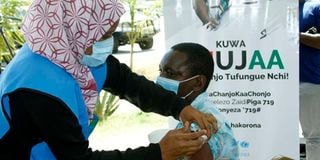Premium
Counties intensify vaccinations to guard against Omicron threat

A nurse administers a Covid-19 vaccine to a traveller at the Standard Gauge Railway Miritini Station. Counties are intensifying vaccinations and reviewing the overall preparedness as the threat of the more infectious Omicron variant looms.
What you need to know:
- Some devolved units have reactivated surveillance teams as experts call for more use of data in response.
- Officials are also encouraging residents to observe the Health ministry protocols to reduce risk of infection.
Counties are on high alert as they prepare to fight the Covid-19 Omicron variant should it find its way into the country.
Health officials are rallying more people to get vaccinated, and urging hospitals to be on standby in case of a surge in hospitalisations and ensure there are enough beds kitted with oxygen and other equipment for intensive care units.
A spot check by the Nation in different parts of the country has revealed that most county health officials are strengthening containment measures that had previously been relaxed. Guidelines like social distancing, handwashing and wearing masks are now strictly being observed in some counties. The devolved units have also intensified vaccinations.
The new Covid-19 mutation has so far been reported in more than 20 countries globally, but Kenya is yet to report a case.
In Kisumu County, which is part of the Lake Region Economic Bloc (LREB), experts are already warning of a fifth wave. They have urged the government to beef up the health workforce and medical supplies so as to avoid a crisis similar to what happened mid this year when the region was marked as a red zone after cases surged due to the Delta variant.
To avoid a disaster, LREB counties have come up with a data analysis dashboard tool called CovidDX that will help them pinpoint hotspots so they can respond proactively.
“With the data, we can study the trends in the spread of the various Covid-19 variants dominant in the region. We will be able to know which areas are overwhelmed,” said Dr Rosemary Obara, LREB’s Health Pillar director.
Dr Shem Otoi, a mathematician who is also part of the LREB eminent persons committee, said a national CovidDX platform would be a noble idea.
“Such a platform will help us know which areas are hotspots, where oxygen is needed, which category of people are getting infected the most, among other important data that can be used for preparedness,” he said.
Turkana County, which has the lowest Covid-19 vaccination uptake, has resorted to using technology to help curb misinformation on vaccines by identifying sources of rumours and tracking down hotspots.
Mass vaccination programme
County health promotion officer Ruth Areman said Covid-19-related rumours have undermined public health, resulting in low vaccine uptake.
“The Covid-19 Vaccine Rumour Tracking Tool we have adopted is meant to provide daily vaccine misinformation collected at the sub-county level,” she said. “Using a risk ranking system, officers across the country can identify rumours that have the highest risk and respond in one voice.”
On its part, Bungoma County has embarked on a mass vaccination programme.
“We are witnessing an increased number of people turning up for vaccination. We have been vaccinating about 50 to 60 people daily at Bungoma Referral Hospital,” said nurse Caroline Lavu.
In Nakuru County, Health executive Gichuki Kariuki said the oxygen plant was being upgraded just in case the Omicron variant hits the region, while in Narok County, Governor Samuel Tunai has asked residents to observe the guidelines set by the Health ministry.
Laikipia County Health executive Rose Maitai said the county government has partnered with well-wishers and private organisations to ensure that frontline workers are protected.
“The Laikipia Health Service-Nanyuki has received an additional Sh1.5 million worth of PPE (personal protective equipment) from the Equity Foundation to boost the safety of our frontline staff in the war against Covid-19,” she said
In Meru and Murang’a, the county administrations are pushing vaccinations. Meru’s Health executive Misheck Mutuma said all the 32 patients hospitalised at Meru Teaching and Referral Hospital are unvaccinated.
“Our strategy is to ensure more people are vaccinated by the end of the year... Our target is to vaccinate 186,000 people by the end of the year,” Mr Mutuma said.
Muranga’s deputy director of medical services Dr Stephen Ngigi said: “It is regrettable that a don’t-care attitude has taken over,” he said.
Rapid response teams
In Nyandarua County, Health executive John Mungai said the department is recruiting more health workers, with a special monitoring unit established.
“We have opened vaccination centres to everyone. We are using every public forum to reach out to the people for both first and second jabs,” Dr Mungai said.
While West Pokot County is enforcing the Covid-19 guidelines, it still lacks oxygen supply in most health facilities.
In the Coast region, Mombasa has equipped facilities with trained personnel in case of a surge. Public Health Chief Officer Pauline Oginga said the county is collaborating with port health services to intensify surveillance at all points of entry.
“We have also scaled up vaccination in our facilities,” Ms Oginga said.
In Kilifi, officials have reactivated rapid response teams at the sub-county level to enhance surveillance.
“We have also prepared our isolation facilities in case of any eventuality. We are ensuring we have enough supply of PPE and sensitising people on the importance of adhering to the health protocols,” said Erick Maitha, the Covid-19 incident commander.
He added that cases of the respiratory disease had gone down in Kilifi and residents had begun dropping their guards.
“But we now urge everyone to wear their masks, wash hands and maintain social distance,” he said.
Lamu Health executive Anne Gathoni said a campaign urging locals to visit health facilities to get the Covid-19 jab was also underway.
By Hellen Shikanda, Elizabeth Ojina, Mwangi Muiruri, David Muchui , James Murimi, Waikwa Maina, George Sayagie, Steve Njuguna, Francis Mureithi, Brian Ojamaa, Oscar Kakai, Tom Matoke, Sammy Lutta, Winnie Atieno, Kalume Kazungu and Maureen Ongala





